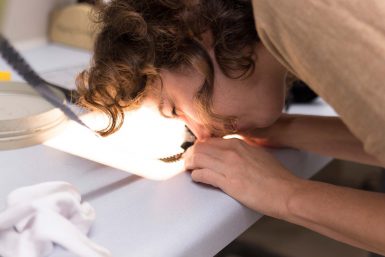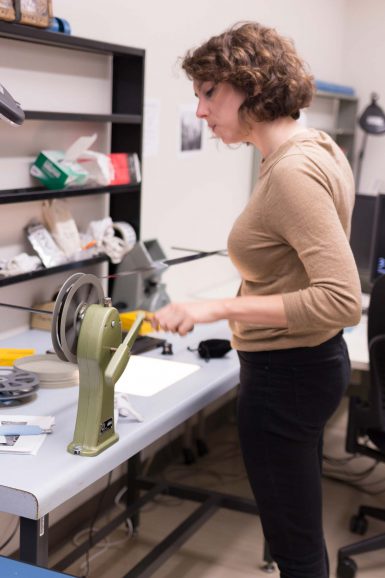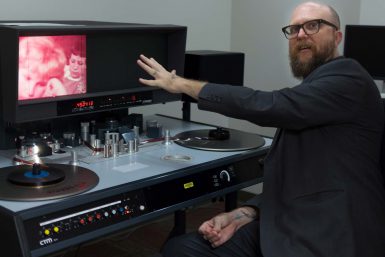IU Libraries Moving Image Archive offers film resources to students

Washington, D.C. commutes aren’t something Rachael Stoeltje often takes part in, but she was happy to make an exception for a unique collection housed in the nation’s capital.
In Stoeltje’s seven years as the IU Libraries Moving Image Archive Director, she “almost never” picks up collections in person. But this collection was different, because it wasn’t film — it was equipment, traveling cross-country from D.C. to Bloomington.
“The equipment is delicate — especially these early cameras and projectors, so we packed them and handled them with care,” she said.
The large collection consisted of 177 cameras and 42 projectors, which Stoeltje hopes will be used in IU film classes for small-gauge filmmaking and exhibition.
“These items teach how films were made, who could make them, and how they were presented or projected,” said Stoeltje.
Stoeltje and her staff of seven — and growing — curate the collection of more than 86,000 films in the IULMIA to preserve history and educate students. According to its website, the film collection covers almost 80 years of film, which can all be found using IU Libraries online catalogue.
The physical collection, one of the world’s largest of training and education films, came from humble beginnings.
Over the years, IU collected, distributed and produced countless films since the early 1900s. Those films became the Audio-Visual Center and stayed under that name for many years. Finally, the Audio-Visual Center collection was sent to the IU Libraries in the 1990s and became what it is today.
By 2008, when Stoeltje was part of the IU Libraries team, various collections came together under one roof and became the Libraries Film Archive. It was later renamed the IU Libraries Moving Image Archive and found a home in the ground floor of Wells Library.

“We have created a workspace for the archivist to process, inspect and view films,” she said. “And most importantly, we work with students — researchers and students who we mentor on the job for those interested in our field.”
Sean Massura, a sophomore in The Media School, got involved with the IULMIA his first year on campus after finding it during freshman orientation.
“My parents and I were walking around campus, and made our way to the library to check it out,” said Massura. “As we wandered into the basement, I noticed the Moving Image Archive, and essentially just walked right in.”
Within 20 minutes, Massura was with Stoeltje, discussing an opportunity to work there in the fall. Since then, Stoeltje has become a mentor and “second mom” to Massura.
Massura enrolled at IU as a business student, but soon found he felt more at home among film reels and documentaries.
Any time not studying film production, Massura decided, was wasted time.
For the better part of the year, Massura said he’s worked on The Holland Collection, a collection of home films about the life of military surgeon and Bloomington resident Phil Holland. The films date as far back as 1937.
“The collection spans 50 years and several countries, so it has some super interesting and diverse content,” said Massura.
Although training and education films won’t bring large crowds to a movie theater, they still have an important place in history.
“We have movies that you or I might look at and think, ‘That’s kind of boring,’” said Media School doctoral candidate Andy Uhrich, a film archivist and assistant librarian. “But play it for someone else who’s an expert in that material, and they get super excited.”

Even though the staff watches and archives each film with care, they do have personal favorites.
“I could go on and on regarding favorite films and collections,” said Stoeltje. “However, I fell in love with film many years ago through the Golden Age of Hollywood films.”
Uhrich reluctantly narrowed his countless favorite films in the collection down to one: Grass Roots, directed by Ed Feil.
“That’s the hardest question to answer, because it really could be the one that came across my desk most recently and caught my eye,” Uhrich said.
The films in the archive haven’t been collected to sit on a shelf in the back of a closet, however. The films have been meticulously digitized and uploaded to IUCAT. Film students in The Media School can take advantage of the resources offered by the IULMIA online or in person at the Wells Library.
Uhrich said students can use the IULMIA for research such as watching movies from different time periods to determine how to mimic a style of filmmaking from a particular era. They can also go to the resource room to see the physical film of previous periods and how it has changed over time, or use the films as primary resources for historical research.
The biggest coup, however, of the IULMIA’s recent move to the Wells Library was its acquisition of a state-of-the-art screening room. All IU students have access to the screening room, where they can:
- Use the “tech check” room to test audio and visual clarity while in a theater setting
- Hold private screenings for friends or critics of self-made film
- Hold public screenings for a completed self-made film
- Curate a personal collection and have it played for friends
Massura recently used the screening room to view a sizzle reel he created for the Holland Collection.
“It was really nice to see the video play up there on the screen, because I’ve been working with this collection for months,” Massura said. “That was the first satisfying step toward having the end in sight.”
More:

